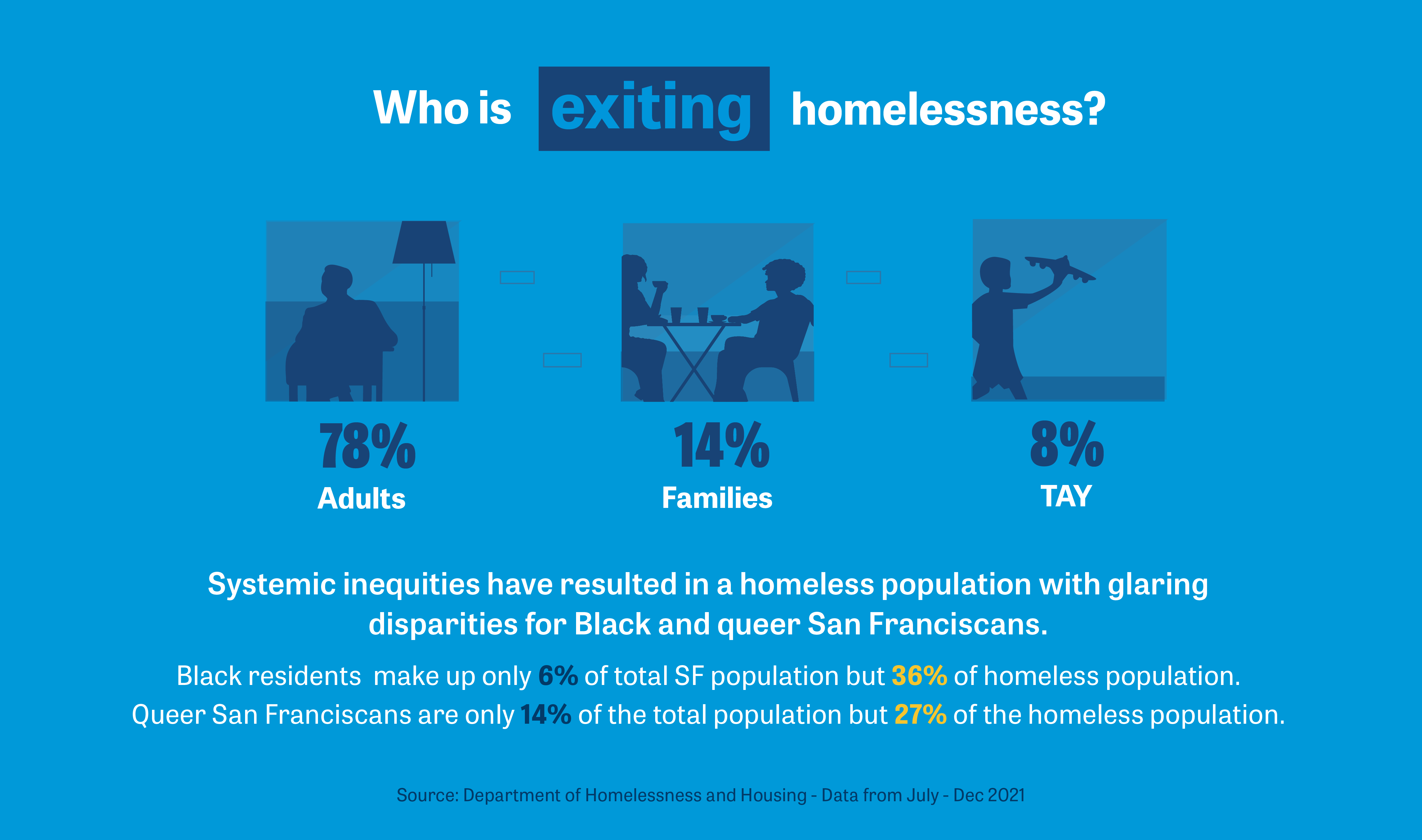From homeless to housed: April Snapshot
Every month, we track the number of people who exited homelessness in San Francisco so we can determine if we are on pace to meet our housing goals for the year. Staying on top of this information helps us ask the important questions – of ourselves and others – to make sure we are doing everything possible to get people off the streets and into homes.

The wonderful news this month is that we are on track to significantly outpace the number of people who exited homelessness last fiscal year. Through February, 1,156 people have exited homelessness, compared to a total of 1,241 through all of last fiscal year. With four months to go in this fiscal year, we could end the fiscal year with approximately 40% more people ending their homelessness than last year. That would be remarkable, and hopefully evidence that the work that the City is doing to make the homelessness response system more effective and efficient is paying off.

At the same time, the City is also increasing its efforts to prevent more people from becoming homeless in the first instance. This is critical because, as the saying goes, an ounce of prevention is worth a pound of cure. There is no question that it is the better and cheaper solution for our entire community to prevent a person or family from becoming homeless than it is to find housing for them after suffering the pain and trauma of homelessness. And, while homelessness prevention is certainly not new, the scale of the City’s effort and some of the strategies are.
Here is a short primer on how the City is approaching this important work.
Homelessness Prevention Tools: A Primer
Rental Assistance
First, funds from the American Rescue Plan and State programs were used to establish programs to help San Franciscans impacted by COVID-19 remain in their homes. As of April 11, 2022, 23,000 households have applied for assistance with rent and utilities totaling over $373 million dollars and approximately $144 million dollars has been distributed. The State has promised to help everyone who submitted applications before March 31, 2022, so the hope is that all of the money requested will be distributed to those in need. And, as you may have heard, the eviction moratorium has been extended until June 30, 2022 for renters who are awaiting payments from state and local programs. These funds and eviction protections are critical to ensuring that we do not see skyrocketing homelessness in the coming months.
Rental Vouchers
Second, as you may recall, the federal government awarded San Francisco 906 emergency housing vouchers specifically for unhoused residents and those at risk of homelessness. The City has promised to allocate 23% of these emergency housing vouchers to households at risk of homelessness, which will enable more than 200 households to remain housed. Significantly, these are “lifetime” housing vouchers, meaning that these households will remain housed for the long term.

Flexible Funds
Finally, San Francisco has stepped up “problem solving,” a strategy that supports households in resolving their housing crisis without entering our shelter system or a housing program. Problem solving is grounded in the belief that individuals are resilient and know best what they need to secure or maintain housing. It is also a recognition that not every household needs multi-year supportive housing, nor can the City provide that type of ongoing intervention to everyone experiencing housing insecurity.
Problem solving is run by nonprofit service providers who work with individuals to identify creative solutions that can address their crisis in real time. Problem solving is intended to be flexible enough to meet a wide range of needs; funds have been distributed to cover everything from moving costs to security deposits to pest extermination.
While we know that problem solving is not the right strategy for everyone facing housing insecurity, it has been shown to help approximately 10% of people who come to our City’s access points. Even a 10% success rate reduces the strain on our shelters and other systems of care.
And, notably, individuals can return to seek further help if the initial effort to resolve their housing crisis does not work. The City is now working to make problem solving available at more access points and also endeavoring to add more services like employment support so that we are better able to meet the needs of our unhoused residents.
We don’t often hear the stories of the people who have—with or without outside support—been able to resolve their own housing crises. Yet, we know that it happens every day. But, it is challenging, and, as the price of housing continues to rise, the challenge only grows.
As a community, we need to improve our ability to support our neighbors who are struggling to keep a roof over their heads. That is why it is so important that the City is embracing a multi-faceted approach to prevention, and focusing on creating a system that is better able to meet individuals where they are not where we think they should be.
We need you! All In is a campaign built on the people of San Francisco, and here’s how you can show up for our unhoused neighbors:
- Share this blog with three friends/colleagues on Facebook – Twitter to start a meaningful conversation about homelessness in our community.
- The solutions to homelessness start with YOU. Click below to sign the All In Pledge.
Stay up to date with the latest news about homelessness and housing in SF:
- Mayor Breed promised to bring tough love to the troubled Tenderloin. Did she deliver?
- Two Bay Area affordable housing projects just scored state funding
- How investing in public health could cure many health care problems
- Bay Area Counties Fight for Greater Health Equity for Black Mothers




